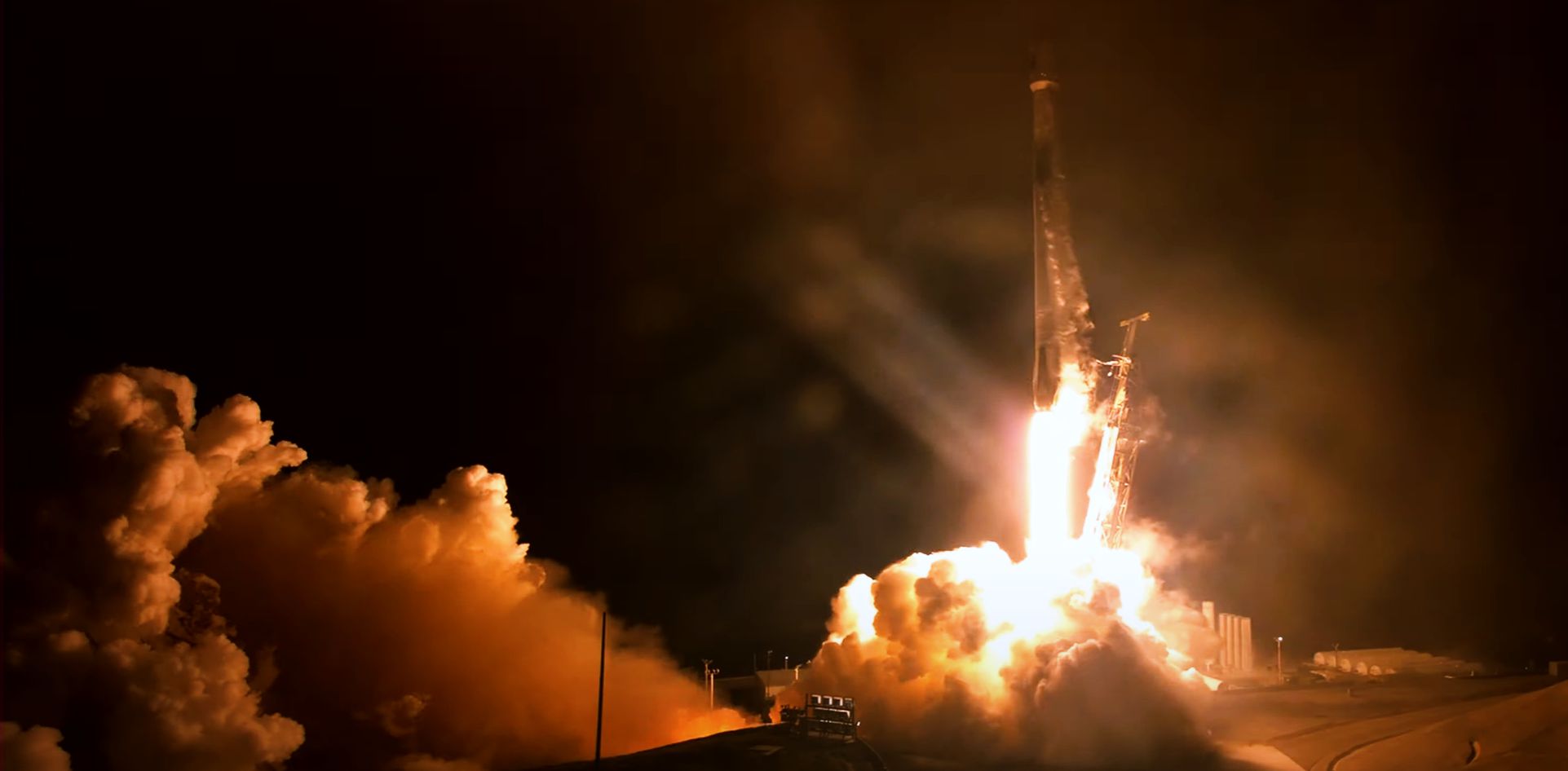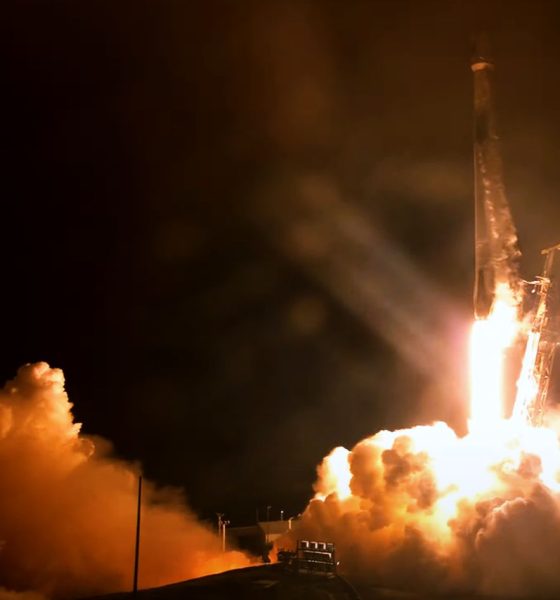

News
SpaceX ties 42-year-old Soviet record with last launch of 2022
SpaceX has tied a 42-year-old record with its 61st and final Falcon rocket launch of 2022.
Also marking the latest in a calendar year SpaceX has launched a rocket, a Falcon 9 lifted off from the company’s Vandenberg Space Force Base (VSFB) SLC-4E pad at 11:38 pm PST, Thursday, December 29th (7:38 UTC 30 Dec) carrying a tiny Earth observation satellite for Israeli company ImageSat International. Built by Israeli Aircraft Industries, the EROS C3 space telescope is the third of its kind and likely weighed just 400 kilograms (~900 lb) at liftoff, utilizing less than 1/40th of Falcon 9’s available performance in a reusable configuration.
The extremely light payload precluded the need for SpaceX to send drone ship Of Course I Still Love You (OCISLY) several hundred kilometers into the Pacific Ocean, likely saving several hundred thousand dollars. Instead, Falcon 9 booster B1061 lifted off for the 11th time, carried EROS C3 and an expendable Falcon 9 upper stage most of the way into space, and then boosted back towards the California coast to land less than a quarter-mile from SLC-4E.
EROS C3 was SpaceX’s 170th consecutively successful Falcon launch, 160th successful landing, and 132nd launch with a reused booster. But more importantly, the mission was also SpaceX’s 61st successful Falcon launch this year, tying a record that hasn’t been touched since 1980.

The update that's rolling out to the fleet makes full use of the front and rear steering travel to minimize turning circle. In this case a reduction of 1.6 feet just over the air— Wes (@wmorrill3) April 16, 2024
In 1980, after two decades of gradual buildup, the Soviet Union managed to launch variants of its R-7 workhorse rocket 64 times in one calendar year. 61 of those launches were successful, setting a record that has been left unchallenged for decades. Only the R-7 family ever posed a threat to its own record, managing 55 successful launches in 1988, but its launch cadence – heavily driven by disposable Cold War reconnaissance satellites – plummeted with the fall of the Soviet Union and has never recovered.
Only in 2022, almost half a century later, has the R-7 family finally found a worthy challenger for its annual launch cadence record. That the challenger is a private company that had to legally force its way into parts of the US launch industry is arguably one of the deepest possible condemnations of the relative stagnancy US space launch capabilities experienced after the Apollo Program. But it also makes SpaceX’s achievement – accomplished with rockets that did not exist before the late 2000s – even more impressive.
Similar to the Soviet peak, an extraordinary period during which the R-7 family successfully launched 1181 times in 22 years, there is one main driving force behind the recent surge in SpaceX’s launch cadence. But instead of the Cold War, the force behind Falcon’s rise is SpaceX’s own constellation of Starlink internet satellites. Since operational launches began in November 2019, Starlink satellites were the primary payload on 66 of the last 125 Falcon launches. In 2022 alone, SpaceX launched 34 Starlink missions.
In 2021, SpaceX completed 31 Falcon 9 launches, 17 of which were Starlink missions. In 2022, SpaceX’s 61 Falcon launches nearly doubled that peak year over year. For a few reasons, that annual doubling is unlikely to repeat itself anytime soon, if ever, but CEO Elon Musk has still issued SpaceX a target of 100 launches in 2023 – a 64% increase year-over-year.
Even that target will be a major challenge, but the EROS C3 mission holds a clue about one of the ways SpaceX can squeeze more out of its existing rockets and launch pads without needing to smash records. SpaceX’s busiest pad, Cape Canaveral’s LC-40, managed nine launches in the last three months of 2022. Its Kennedy Space Center LC-39A pad managed 18 launches over the year. Finally, EROS C3 was SLC-4E’s 13th launch of 2022.
While the California pad came in last, it does not have the same cadence constraints (Dragon and Falcon Heavy missions) as Pad 39A. And less than 12 days ago, SpaceX’s West Coast SLC-4E helped launch NASA and France’s SWOT water observation satellite. Having repeatedly demonstrated the ability to launch two Falcon 9 rockets in less than 12 days, SLC-4E has the potential to carry much more weight in the future. If SpaceX can improve the pad’s ease of use, it could feasibly support 20-25 launches per year, and potentially 30+ with further optimization.
With SLC-4E operating at a cadence of 25 launches per year and LC-40 and LC-39A both operating as-is, SpaceX could launch approximately 80 Falcon rockets in 2023. Ultimately, if SpaceX can maintain the Falcon family’s unprecedented streak of successful launches and improve the uptime of its existing pads, it’s hard to see the R-7 family’s annual cadence record making it to 2024. SpaceX also has a clear (but steep) path to 90+ Falcon launches next year, though simply mirroring its 2022 performance would still be an extraordinary feat.

News
Tesla stands to gain from Ford’s decision to ditch large EVs
Tesla is perhaps the biggest beneficiary of Ford’s decision, especially as it will no longer have to deal with the sole pure EV pickup that outsold it from time to time: the F-150 Lightning.

Ford’s recent decision to abandon production of the all-electric Ford F-150 Lightning after the 2025 model year should yield some advantages for Tesla.
The Detroit-based automaker’s pivot away from large EVs and toward hybrids and extended-range EVs that come with a gas generator is proof that sustainable powertrains are easy on paper, but hard in reality.
Tesla is perhaps the biggest beneficiary of Ford’s decision, especially as it will no longer have to deal with the sole pure EV pickup that outsold it from time to time: the F-150 Lightning.
Here’s why:
Reduced Competition in the Electric Pickup Segment
The F-150 Lightning was the Tesla Cybertruck’s primary and direct rival in the full-size electric pickup market in the United States. With Ford’s decision to end pure EV production of its best-selling truck’s electric version and shifting to hybrids/EREVs, the Cybertruck faces significantly less competition.

Credit: Tesla
This could drive more fleet and retail buyers toward the Cybertruck, especially those committed to fully electric vehicles without a gas generator backup.
Strengthened Market Leadership and Brand Perception in Pure EVs
Ford’s pullback from large EVs–citing unprofitability and lack of demand for EVs of that size–highlights the challenges legacy automakers face in scaling profitable battery-electric vehicles.
Tesla, as the established leader with efficient production and vertical integration, benefits from reinforced perception as the most viable and committed pure EV manufacturer.

Credit: Tesla
This can boost consumer confidence in Tesla’s long-term ecosystem over competitors retreating to hybrids. With Ford making this move, it is totally reasonable that some car buyers could be reluctant to buy from other legacy automakers.
Profitability is a key reason companies build cars; they’re businesses, and they’re there to make money.
However, Ford’s new strategy could plant a seed in the head of some who plan to buy from companies like General Motors, Stellantis, or others, who could have second thoughts. With this backtrack in EVs, other things, like less education on these specific vehicles to technicians, could make repairs more costly and tougher to schedule.
Potential Increases in Market Share for Large EVs
Interestingly, this could play right into the hands of Tesla fans who have been asking for the company to make a larger EV, specifically a full-size SUV.
Customers seeking large, high-capability electric trucks or SUVs could now look to Tesla for its Cybertruck or potentially a future vehicle release, which the company has hinted at on several occasions this year.
With Ford reallocating resources away from large pure EVs and taking a $19.5 billion charge, Tesla stands to capture a larger slice of the remaining demand in this segment without a major U.S. competitor aggressively pursuing it.
News
Ford cancels all-electric F-150 Lightning, announces $19.5 billion in charges
“Rather than spending billions more on large EVs that now have no path to profitability, we are allocating that money into higher returning areas, more trucks and van hybrids, extended range electric vehicles, affordable EVs, and entirely new opportunities like energy storage.”

Ford is canceling the all-electric F-150 Lightning and also announced it would take a $19.5 billion charge as it aims to quickly restructure its strategy regarding electrification efforts, a massive blow for the Detroit-based company that was once one of the most gung-ho on transitioning to EVs.
The announcement comes as the writing on the wall seemed to get bolder and more identifiable. Ford was bleeding money in EVs and, although it had a lot of success with the all-electric Lightning, it is aiming to push its efforts elsewhere.
It will also restructure its entire strategy on EVs, and the Lightning is not the only vehicle getting the boot. The T3 pickup, a long-awaited vehicle that was developed in part of a skunkworks program, is also no longer in the company’s plans.
Instead of continuing on with its large EVs, it will now shift its focus to hybrids and “extended-range EVs,” which will have an onboard gasoline engine to increase traveling distance, according to the Wall Street Journal.
“Ford no longer plans to produce select larger electric vehicles where the business case has eroded due to lower-than-expected demand, high costs, and regulatory changes,” the company said in a statement.
🚨 Ford has announced it is discontinuing production of the F-150 Lightning, as it plans to report a charge of $19.5 billion in special items.
The Lightning will still be produced, but instead with a gas generator that will give it over 700 miles of range.
“Ford no longer… pic.twitter.com/ZttZ66SDHL
— TESLARATI (@Teslarati) December 15, 2025
While unfortunate, especially because the Lightning was a fantastic electric truck, Ford is ultimately a business, and a business needs to make money.
Ford has lost $13 billion on its EV business since 2023, and company executives are more than aware that they gave it plenty of time to flourish.
Andrew Frick, President of Ford, said:
“Rather than spending billions more on large EVs that now have no path to profitability, we are allocating that money into higher returning areas, more trucks and van hybrids, extended range electric vehicles, affordable EVs, and entirely new opportunities like energy storage.”
CEO Jim Farley also commented on the decision:
“Instead of plowing billions into the future knowing these large EVs will never make money, we are pivoting.”
Farley also said that the company now knows enough about the U.S. market “where we have a lot more certainty in this second inning.”
News
SpaceX shades airline for seeking contract with Amazon’s Starlink rival

SpaceX employees, including its CEO Elon Musk, shaded American Airlines on social media this past weekend due to the company’s reported talks with Amazon’s Starlink rival, Leo.
Starlink has been adopted by several airlines, including United Airlines, Qatar Airways, Hawaiian Airlines, WestJet, Air France, airBaltic, and others. It has gained notoriety as an extremely solid, dependable, and reliable option for airline travel, as traditional options frequently cause users to lose connection to the internet.
Many airlines have made the switch, while others continue to mull the options available to them. American Airlines is one of them.
A report from Bloomberg indicates the airline is thinking of going with a Starlink rival owned by Amazon, called Leo. It was previously referred to as Project Kuiper.
American CEO Robert Isom said (via Bloomberg):
“While there’s Starlink, there are other low-Earth-orbit satellite opportunities that we can look at. We’re making sure that American is going to have what our customers need.”
Isom also said American has been in touch with Amazon about installing Leo on its aircraft, but he would not reveal the status of any discussions with the company.
The report caught the attention of Michael Nicolls, the Vice President of Starlink Engineering at SpaceX, who said:
“Only fly on airlines with good connectivity… and only one source of good connectivity at the moment…”
CEO Elon Musk replied to Nicolls by stating that American Airlines risks losing “a lot of customers if their connectivity solution fails.”
American Airlines will lose a lot of customers if their connectivity solution fails
— Elon Musk (@elonmusk) December 14, 2025
There are over 8,000 Starlink satellites in orbit currently, offering internet coverage in over 150 countries and territories globally. SpaceX expands its array of satellites nearly every week with launches from California and Florida, aiming to offer internet access to everyone across the globe.
Currently, the company is focusing on expanding into new markets, such as Africa and Asia.








